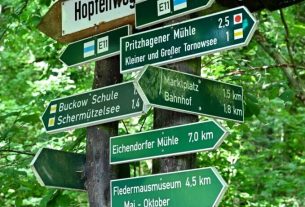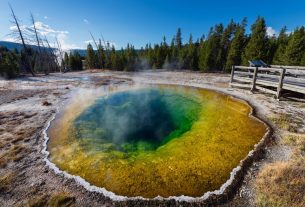The city of Hambach is always on everyone’s lips throughout Germany. The reason: the RWE open pit mine, in which enormous quantities of lignite are mined, and the associated burden on the region and the environment. There was continued criticism, with the huge protests around Hambach Forest and the eviction of the town of Lützerath becoming particularly notorious. Now there are problems again in Hambach, but for the period after the coal phase-out. What it’s about: TRAVELBOOK has a look at it.
In North Rhine-Westphalia, near Cologne, there are gigantic crater landscapes. You can see them from miles away, almost dystopian abysses, about 400 meters deep, with a few excavators and cranes inside. Here, in the open pit mines of Inden, Garzweiler and Hambach, lignite has been mined for decades. But it should soon end, as from 2029 no more coal will be mined in Hambach. What remains are the gigantic pits. At present, the so-called open pits would pose a danger: “They cannot be left as they are, the steep embankments would be too dangerous,” Guido Steffen from RWE points out to TRAVELBOOK. Then the hole must be filled again – with water.

The Hambach open pit mine alone will be flooded with 4.3 billion cubic meters of water over an area of 4,200 hectares. This would make Hambacher See Germany’s second largest lake in terms of volume. Lake Starnberg is currently in second place, although it has “only” a volume of 2.9 billion. The first place goes, by a clear margin, to Lake Constance, which has a volume of over 47 billion cubic meters.
Also interesting: Lake Ladoga is the largest lake in Europe
Plans for Germany’s second largest lake
However: the Hambacher See would still be large and would change the landscape enormously. The idea is not new to him, the project was already conceived in the 90s. The construction of the necessary pipelines and pumps will start at the end of 2024 and the first water should flow in 2030. According to the plan of RWE and the district government of Cologne, the major part should be drawn from the Rhine. The open pit mine in Garzweiler will be filled with water from the Rhine, while the open pit mine in Inden is planned to be extracted from the Rur. For all the lakes, on the other hand, the already existing groundwater must be used in part, which will fill the wells again, at least in part, after the end of operation of the pumps currently in operation.

The lake is expected to be usable for the first time after only ten years of flooding, and the project is expected to be completed according to plan within approximately 40 to 60 years. Instead of the current lunar landscape, there would then be a local water recreation area. “Then there are water sports here, you can go sailing, surfing or swimming and of course there are also areas for nature conservation,” says RWE spokesman Steffen. “There we will see resorts, marinas, coffee shops, beach bars and hotels.” A small Lake Constance near Cologne – it seems like a nice plan at first. But if the residents get their way, the project should be stopped. Why?
Criticism of the residents at the Hambacher See
The biggest concern of local residents is not the finished lake, but the road to it. Because the large construction site, in particular, raises fears of too much noise and traffic from large construction vehicles, and there is currently no compensation for gas flows that could lose customers due to the construction site. A threat to the ecosystem is also seen. The pipes to fill the gigantic pit with water from the Rhine are laid underground. However, a 70m wide strip is still required for the entire length of the construction works. Even what happens in the event of a pipe break and the possible uncontrolled escape of water does not seem to have been fully clarified in the opinion of local residents.
And last but not least, the water itself is also a concern for the local residents. Specifically: the quality of the water. According to the city of Dormagen, “some citizens have commented critically that the water quality of the Rhine is not suitable for filling.” Indeed, the water quality of the Rhine has improved significantly in recent decades, but bathing is still discouraged in many places , for example due to sewage inflows. But the concerns are not shared in RWE. “Preliminary investigations have shown that the water from the Rhine is suitable for filling open pit mining lakes and that the water quality of the resulting lake will allow for a variety of uses. The water quality of the Rhine has improved significantly in recent years and decades. It will certainly continue like this,” says Steffen.
Lusatian Seeland model

However, at RWE you can understand and understand many of the concerns of the residents. One is currently working on fair compensation for residents whose properties would be affected by the construction of the pipelines. Concerns about the appearance of the eight-metre-high, 40-metre-wide pumping station are also being taken seriously, and work is currently underway to integrate it into the landscape. But rethinking the whole project? This is out of the question. “There is no alternative but to fill the mine with water. This is also nothing new, in the Cologne area alone there are 53 lakes that were once open pit mines. Many are now popular destinations,” says Steffen.
A look across the country to eastern Germany also shows that the renaturation of old open pit mines in lakes is well received by many. An example: the Lusatia Lake District. It is a completely artificial lake area, created by the flooding of disused lignite mines. By the end of this decade, the largest artificial water landscape in Europe will be created here. Tourism is already thriving: where once, as today in Hambach, excavators and cranes stood in the middle of barren landscapes, there are now hotels and guesthouses, inns and holiday apartments, campsites and pitches for mobile homes. In the pre-Corona year 2019, the region achieved according to the German Economic Institute for Tourism (dwif) 265.4 million euros in gross turnover from tourism alone.
Guido Steffen is not surprised: “People want these landscapes to feel in touch with nature.” He hopes to see developments like those in East Germany at Lake Hambach as well. Why: “People want these lakes. And we would like to close the lignite chapter in regional history in a few years, with high-quality and sustainable post-mining landscape design. And that includes open-air lakes.






